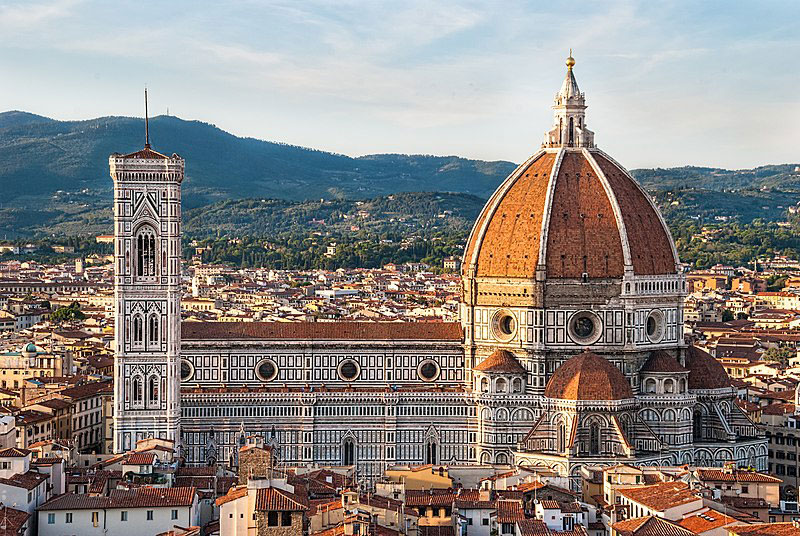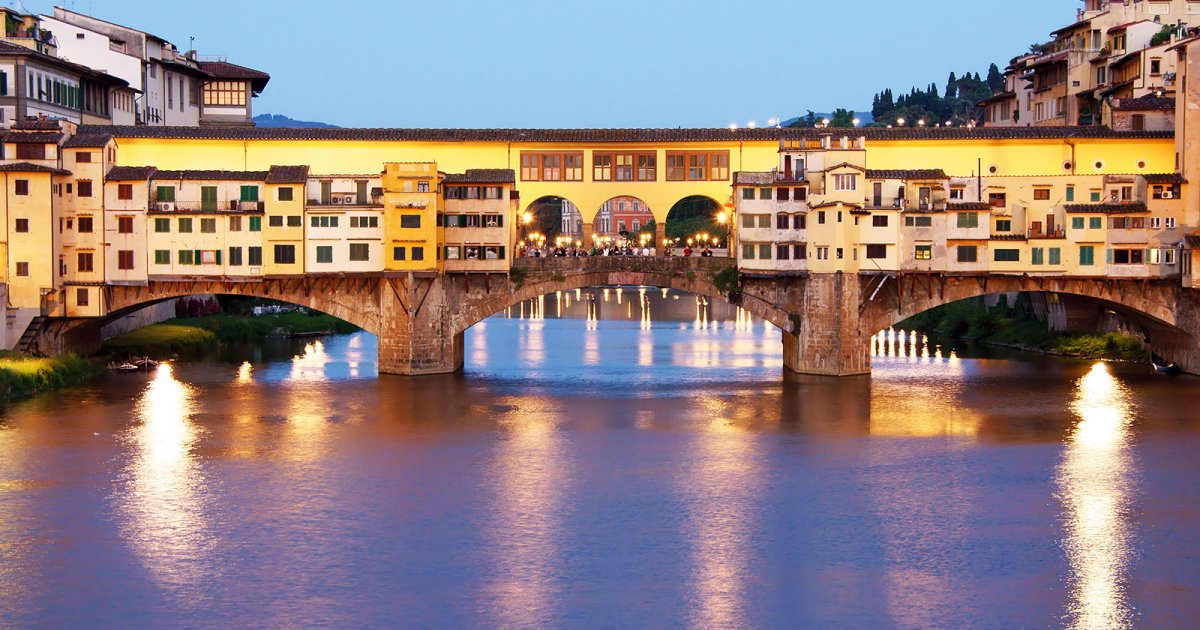Surroundings
Historic places and cities of Tuscany, reachable in 1 hour from the B&B Le Ginestre
Florence
Duomo di Firenze
Brunelleschi’s dome dominates the whole of Florence. The bell tower was designed by Giotto even if he did not see it finished. The baptistery is one of the oldest buildings in the city and its doors are a Bible of images. The Duomo with its white and green marble facade captures the eye. We are in the heart of Florence.
Piazza della Signoria
Piazza della Signoria guest at Palazzo Vecchio, a place that for a long time has been “cursed” because it is a battleground between the Guelphs and the Ghibellines. Having erased the footsteps of a bloody past, this square is now the center of social, civil and political life in all of Florence. At the entrance of Palazzo Vecchio, the copy of Michelangelo’s David.
Ponte Vecchio
Ponte Vecchio is one of the most photographed places in the world. When in 1565 Giorgio Vasari built the Vasari Corridor for Cosimo I of the Medici to unite Palazzo Vecchio with Palazzo Pitti degli Uffizi, passing over the old bridge, the popular shops were closed in favor of artisan goldsmiths, considered to be more suited to the beauty of the place. It tells the story of Hitler, bewitched by such great beauty, he gave orders to save Ponte Vecchio during the bombings of the Second World War.
Uffizi
The Uffizi is one of the most famous museums in the world, a treasure chest of masterpieces from every century and a destination dreamed of by art lovers. The visit begins with the Sala del Trecento, and the three altarpieces by Cimabue, Duccio di Buoninsegna and Giotto, which all depict the “Madonna enthroned with the child”. Then Botticelli, Leonardo, Signorelli, Perugino, Durer, Caravaggio and many others. Plan a full day for the visit.
Palazzo Pitti and Giardino di Boboli
Private park of the residential building of Palazzo Pitti, the Boboli Gardens connects the famous palace of Florence with the Forte Belvedere. 45,000 m², the park houses statues, various residences and museums, and presents an architectural structure with a landscape bar that makes it unique in the world. The garden also includes the Museo degli Argenti, the Costume Gallery and the Porcelain Museum. An enormous panoramic terrace from which to enjoy a spectacular view of the city, Piazzale Michelangelo, was built when Florence became the capital of Italy, the panorama of the square sets a striking view: the bridges follow each other elegantly, illuminated by the colors that are reflected on the waters of the ‘Arno, the whole city is within sight, as are the hills that embrace it.
Pisa
Piazza dei Miracoli
Piazza dei Miracoli is the most important artistic and tourist center of Pisa. The leaning tower is the most famous monument of the square. The bell tower was built between the 12th and 14th century, and its slope is due to the ground ceded already in the early stages of construction. The tower of Pisa has been proposed as one of the seven wonders of the modern world. The Cathedral Santa Maria Assunta, is the most significant example of Pisan Romanesque art, bearing witness to the prestige that the Maritime Republic achieved. Its construction began in conjunction with the reconstruction of the basilica of Venice. It is probable that a tacit competition for the creation of the most beautiful and sumptuous place of worship was born between the two cities. The baptistery of Pisa and the work of the architect Dio saved you, but many sculptures on the façade were made by Nicola Pisano and his son Giovanni. Also by Nicola Pisano, the Pulpit which presents scenes from the life of Christ and subjects depicting the virtues. The baptistery of Pisa is the largest baptistery in Italy the last wonder is the monumental cemetery a sacred place because the crusaders bring it here the Holy Land taken on Monte Golgota. There are works of art from the Etruscan to the Roman and medieval ages up to masterpieces of the last century.
Piazza dei Cavalieri
Piazza dei Cavalieri takes its name from the headquarters of the order of the knights of Santo Stefano. Example of Renaissance architecture. Next to it is the clock building, a medieval building with the hunger tower where Conte Ugolino della Gherardesca died with his children and grandchildren, a story told by Dante Alighieri in the Commedia.
I Lungarni
The Lungarni are both important meeting points for young Pisans and points of reference for tourists. They house buildings dating back to the Middle Ages. On the Lungarno Gambacorta there is a small Gothic jewel, the church of Santa Maria della Spina. If you are in Pisa on June 16th, don’t miss the Luminara di San Ranieri: the lungarni are illuminated by numerous small flames creating suggestive plays of light and colors.
Murale di Keith Haring
In 1989, passing through Pisa, Keith Haring left the city with an extraordinary work of art: It is the “Tuttomondo” mural painted on the rear façade of the convent of the friar servants of Mary of the church of San Antonio.
La Certosa di Calci
The Certosa di Calci is about 10 km from the city. Inside the Certosa, today is housed the natural history museum of the University of Pisa, which includes paleontological mineralogical and Zoological collections. The museum houses one of the largest cetacean galleries in Europe.
Lucca
The walls of Lucca
The walls of Lucca, a beautiful tree-lined avenue where you can walk, play sports, or enjoy the view over the roofs of the city (4.23 km). They are the only example of defensive walls of the modern age that arrived intact up to our days. They were built between 1504 and 1645 on a project by Alessandro Farnese and fortunately they never served to defend the city from a siege.
Piazza dell’Anfiteatro
Piazza dell’Anfiteatro or round square, it was built by architect Nottolini dot, sacrificing most of the Roman buildings. Access is from four small vaulted doors. The shops, the bars, the outdoor tables of the bars make it the heart of Lucca, a compulsory point of passage and stop for tourists.
The Guinigi Tower
The Guinigi Tower was commissioned by the rich and powerful Lucchese merchant family. 45 m high on the top of a hanging oak garden, where their shade is ideal to recover from the 230 steps.
Museo Nazionale Palazzo Mansi
Museo Nazionale Palazzo Mansi a 17th century building belonging to the Mansi family, it houses the most important collection of Lucca paintings (83 works).
The Cathedral of San Martino
The Cathedral of San Martino is another special place in Lucca. From the imposing religious building of Romanesque style, one is struck by the symmetry of the facade. Inside You can see the statue of San Martino and the Povero, the last supper by Tintoretto and the statue of Ilaria del Carretto, by Jacopo della Quercia.
The Botanical Garden
The Botanical Garden is located in the historic center. A splendid garden extended for 2 hectares, wanted by the Countess Maria Luisa di Borbone. A prestigious history is an important present which made it a very rich nursery with hundreds of species inside.
House of Puccini
In the heart of the city, the apartment on the second floor where he was born, became the Puccini museum in 1989. The first approaches to music are witnessed, in this magical place, by objects belonging to the composer: scores, instruments, letters, even stage costumes.
Garfagnana
Grotta del Vento
The most spectacular karst caves of the Apuan Alps, the Grotta del Vento is a system of caverns that develops inside the Pania secca. Three itineraries are available: the first flat area is rich in calcareous concretions; the second with a deep chasm, is crossed by an underground river. The third is characterized by large halls and a large well.
Ponte del Diavolo
Near Borgo a Mozzano stands an imposing medieval building that connects the two banks of the river bucket; built in the 14th century by order of Matilde di Canossa; the Ponte della Maddalena, better known as the Devil’s Bridge. According to legend, the bridge would have been built overnight after the devil intervened, mocked, however, by the astuteness of the inhabitants.
















